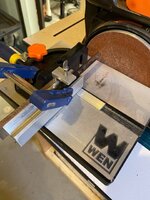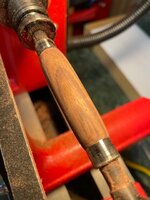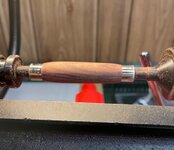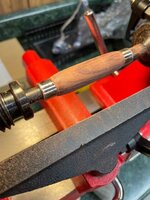RGVPens
Member
OK...I've NEVER turned anything on a lathe! I cut and drilled (on the lathe) my blank. I epoxied the tube (after scuffing) it in and waited overnight.
The picture shows how I set it up. I have carbide tools. I'm turning Rosewood.
I started to turn it...but the blank would stop on the mandrel even barely touching it with the tool. I thought I had better get some advise before I go too far.
No need to reinvent the wheel...just ask first!
1. Is my setup right?
2. How tight can I put it on the mandrel?
3. What speed should I set it on? Turncrafter VS10
4. Is the round head on the tool easier to start with...or the square?
5. Hold tool level with the numbers on the carbide bit facing up?
6. When starting, work from the center to the ends to round the blank?
Any other first time advise you can think of? I'm sure after I've turned the first one or two I'll have a much better idea of what to do and what not to do!
We're headed to Mexico for the day, I'll read the replies this evening. After Margaritas in Mexico, I'll probably wait till morning to try turning...LOL
Thanks!

The picture shows how I set it up. I have carbide tools. I'm turning Rosewood.
I started to turn it...but the blank would stop on the mandrel even barely touching it with the tool. I thought I had better get some advise before I go too far.
No need to reinvent the wheel...just ask first!
1. Is my setup right?
2. How tight can I put it on the mandrel?
3. What speed should I set it on? Turncrafter VS10
4. Is the round head on the tool easier to start with...or the square?
5. Hold tool level with the numbers on the carbide bit facing up?
6. When starting, work from the center to the ends to round the blank?
Any other first time advise you can think of? I'm sure after I've turned the first one or two I'll have a much better idea of what to do and what not to do!
We're headed to Mexico for the day, I'll read the replies this evening. After Margaritas in Mexico, I'll probably wait till morning to try turning...LOL
Thanks!




